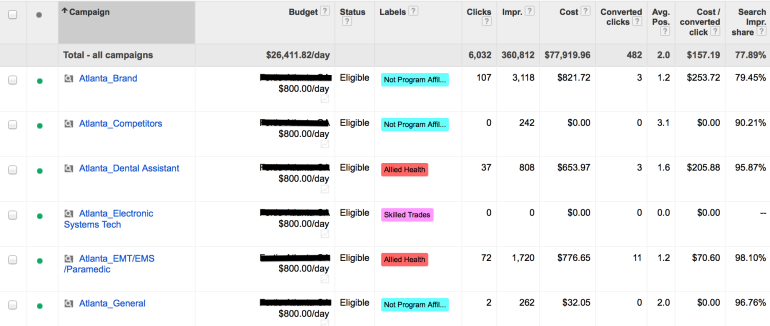Prior to my career in paid search, I spent time designing databases. It was instilled in me that a great structure was key to a great database. If the structure were laid out in a clean, logical manner, the data quality and integrity would be far superior.
The same holds true for PPC accounts. Campaigns with tightly themed ad groups and targeted keyword sets will usually outperform looser structures where ad groups contain broader keyword sets of varying themes.
Let’s dive in and take a look at a couple of account structure examples. Structure A was a poorly conceived structure we inherited from a client when taking over their account. Structure B is a restructured version of structure A. We’ll discuss the biggest reasons why account structure A ultimately failed and why account structure B has been a success.
Account Structure A
Below is a snapshots of an account structure we took over about a year ago. This is from an education account with multiple locations around the United States.
Each location was broken down into 3 duplicate campaigns with the only variation being keyword match type. For example, the campaign names would be something like ‘Location X (B)’ ‘Location X (P),’ & Location X (E). The B, P, & E, stands for Broad, Phrase, & Exact.
Think of the campaigns not as a theme but rather as a location targeting shell. Within these campaigns were 1000’s of ad groups containing every variation of keyword related to the program offerings for that particular location. For instance, nursing ad groups would be intermingled with medical assistant, HVAC, and business ad groups.
So why did this campaign structure ultimately fail? Listed below are the main reasons that contributed to the lack of success of account structure A.
- Match type campaign versions provided a fragmented view of performance. Very rarely could we get complete performance data without it being so time intensive that the data was outdated by the time the analysis was completed.
- Programs were all lumped together instead of separated into their own campaigns. This caused campaign wide CTR% to suffer, ultimately hurting quality score and ad rank.
- Inability to Budget: High and low CPC programs were co mingled. For example, nursing (very high CPC keywords) resided in the same campaign as surgical technology keywords (low CPC keywords). Only a few clicks on the nursing keywords would exhaust budget, which in turn did not allow the lesser expensive keywords to show.
- It was extremely difficult to perform optimizations and expansions. Ad groups would always seem to get missed during an optimization or an expansion because it was either hard to identify them within the account or we would be working in the wrong campaign version of that ad group.
Key takeaway from this example is if your account structure makes it harder and longer to optimize, grow, maintain, or report on performance, its probably time for a change of structure.
Account Structure B
Below is a snapshots of ‘account structure B’. Account structure B is laid out in a simpler, more logical manner. The structure is very easy to follow and allows for easy identification of campaigns and ad groups in need of optimization or expansion.
In addition, budgeting, a complicated task when each location has very specific spending targets, can be done through shared budgeting. This features allows all campaigns assigned to them an equal chance to accrue spend, or each program can be budgeted separately in order to give priority to more important campaigns vs. less important ones.
In addition to budgeting, the main reasons this account structure has been successful are:
- Each program has is its own campaign. Having all of a program’s keyword match types together in one place has raised quality scores and improved CTR.
- Easier to maintain. It takes much less time to complete expansion projects or routine maintenance as a day or multiple days for a single project.
- Reporting is much less complicated. At a glance, we can see top line performance trends. We’re now able to perform the in depth analysis required to get the true insights into what’s driving performance.
- Ability to examine how program performance varies from location to location. This has provided insights on how to improve lagging performance in other locations.
Structure B caused us to double the amount of campaigns in the account. However, we were actually able to slim down the size of the overall account. Originally, there were 195K active ad groups. Now we’re down to 43K. While still a tremendous amount of ad groups, account structure B is much easier to maintain.
Closing Thoughts
Be sure to regularly evaluate your account structure and decide if it’s meeting your needs. A successful account structure is one that maximizes ad exposure, allows for ease of optimization, is easily expandable, and simple to report against. If your account structure incorporates these basic principles, there’s no reason why your PPC program can’t be quite successful.






